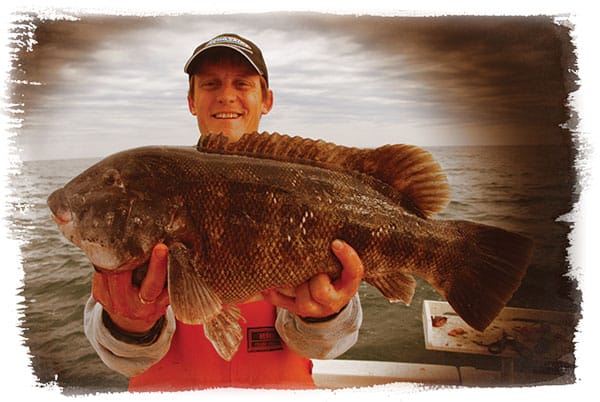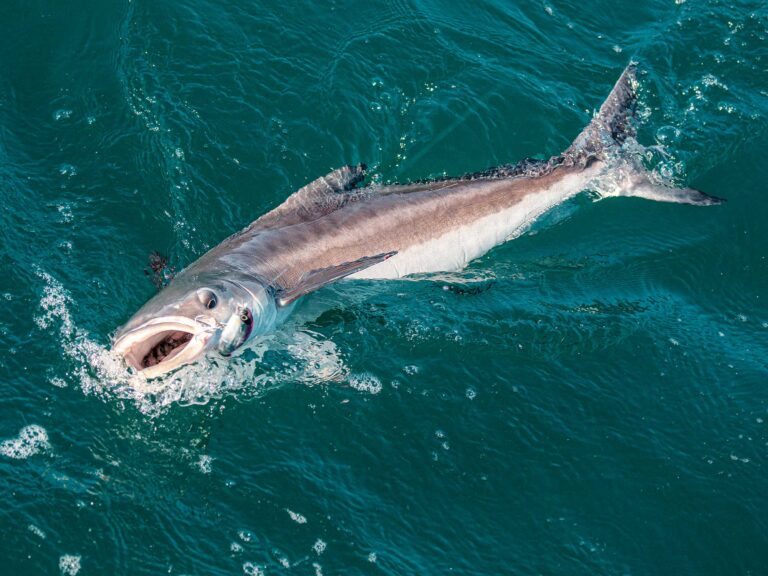Textbooks identify these deep-dwelling freaks as tautog (“blackfish” to Northerners), but in the angling world, these scaly sea creatures are known simply as “tog.”
Deepwater tog can weigh up to 20 pounds, and in some cases, exceed that mark. Fluctuating water temperatures in the transition between winter and spring make monster tog even more precocious than their inshore counterparts. Detecting the light nibble of a tog in shallow depths is not easy, and it becomes more difficult when one taps your bait 100 feet down. Add the complications of anchoring in deep water, crosswinds and powerful current, and you begin to understand the challenge of tog fishing.
Tog Tactics
Water temperature plays a key role in the bite, but tog experts argue about the actual magic water temperature. I’ve experienced great fishing in water as cold as 42 degrees, but sometimes togs prefer warmer water.
It seems as though fish of a certain size congregate on specific portions of the wreck. One piece might be infested with small tog, while another chunk will be covered in monsters.
To find trophies, the best strategy is to chart a course that covers wrecks from 50 to 150 feet deep. I start shallow, and then curve northeast while stopping at deeper structure. On the way back, I swing southwest and hop from wreck to wreck all the way back to 50 feet.
Anglers might cover a lot of miles in search of deepwater tog, but the difference between catching and not catching can come down to a matter of inches. Literally, a few feet can mean the thrill of victory or the agony of defeat.
Situating the boat over the structure is the toughest part. As soon as I mark the wreck on the fish finder, I take the engine out of gear and let the boat drift away from the mark.
I watch the plotter to determine how the current and wind are pushing the boat. Then, I run the boat on the back azimuth across the wreck, and continue beyond the structure until I’m far enough ahead to throw the anchor.
How far? Well, if I’m using a wreck anchor made of bent rebar, I go far enough past the structure that the hook has a chance to reach the bottom and snag the wreck as I drift over.
In deep water, a Danforth anchor is a better choice. To keep the anchor from getting snagged on the reef, it’s best to use a boat-length of heavy chain, and let out three times as much rope as the depth of the water. In other words, if the water is 100 feet deep, it might take 300 feet of anchor rope to get into position.
Once secured over the wreck, the structure should show up on the fish finder. If not, bring in rope, let out rope, tie off to another cleat, or pull the hook and reset.
Tips from the Pros
Not many people can claim to be a deepwater-tog expert. That’s because few anglers are willing to spend the money, hours and miles required to figure these fish out. Capt. John Nedelka out of Indian River Inlet, Delaware, and Virginia Beach’s Capt. Skip Feller have each been chasing monster tog for more than 30 years. When these guys talk tog, anglers listen.
“Water temperature on the bottom is critical,” stresses Nedelka. To determine the temperature in tog-ville, Nedelka uses a boat rod to drop a high/low thermometer to the wreck. “I’m looking for 41 to 46 degrees,” he says.
Feller recommends a two-speed reel. “I use high gear to quickly check the bait, and then switch to low gear for the fight,” he says. When battling tog, Feller says that a high-speed reel puts too much pressure on the fish and increases the risk of pulling the hook.
To cover the most structure without having to pull the anchor, Nedelka simply runs the rope from different points on his boat. “I have nine rope chocks on my boat,” he says. “By changing the angle, I can change the location of the boat on the wreck.”
Feller goes to great lengths to get the best bait. In addition to hard crabs and clams, he’s built special pots to catch Jonah crabs off Virginia Beach. “I can’t get them anywhere else,” he says, “and the tog love them.”
Nedelka prefers a single-hook rig. “Guys who bring two-hook rigs just lose twice as much bait,” he says.
Instead of anchoring, Feller uses the engines to hold his boat over the wreck. “That way we cover more structure before determining where we’ll anchor up.”
While it’s rare to mark tog on a fish finder, Nedelka looks for other fish on the wreck. “If there is no bait,” he says, “then there probably aren’t any tog either.”
Among tog anglers there is a great debate: “I’ve got one regular customer who always leaves the legs on his blue crab,” Feller says, “and another guy who cuts them off.” Feller claims both catch an equal number of fish.
Nedelka swears by fluorocarbon leader. “I’ve seen guys using fluoro who out-fish the rest of the boat 5-to-1,” he says, “especially on days when the water is clear.”
Not only are tog bait thieves, but their tactics change each day. “Some days they snatch the bait, and some days they just lie on it,” Nedelka says. However, he has noticed if the first fish bites lightly, then all the fish that day will bite lightly. “I can’t explain it,” he says.
Endgame
Once the bait is in the zone, keep the line tight by moving the rod tip up and down as the boat rises and falls on the waves. In order to detect slight nibbles, lightly pinch the line coming off the reel.
At the first tap of a tog, lift the rod tip hard and start cranking. Don’t stop. Tog will take advantage of any slip-up.
When the fish takes control, let the drag do the work. Keep the rod tip high, and gently thumb the line to add a few more ounces of pressure.
If the tog takes refuge in a crag, give it some slack and wait. Many times, the fish will swim out of the snag and resume the fight.
Tog are sneaky bait thieves, but they fight like a bulldog. They might be ugly to look at, but they sure are pretty on the plate. Searching out trophy fish in deep water takes the sport to a whole new level. But you had better bring your A game to this fight because you can bet the tog will

Deep Water Big Tog

Deep Water Fishing for Tog

Deep Water Fishing for Tog










